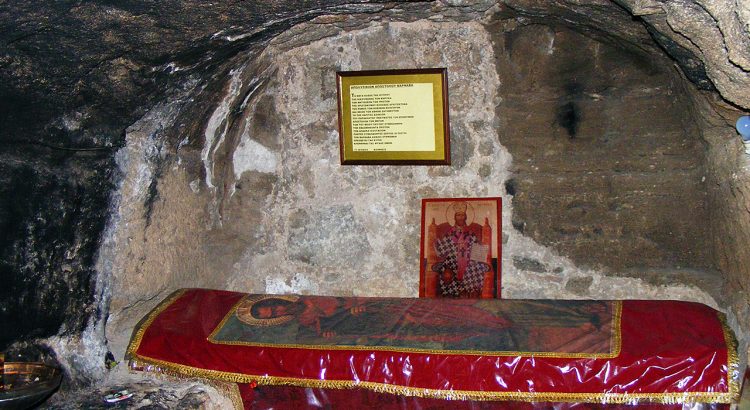“This book has more an air of truth about it than any of the others. There is not much extravagance in the details, and the geography is correct, showing that the writer knew Cyprus well. It seems to have been written at all events before 478 in which the body of Barnabas is said to have been found in Cyprus.”
– Alexander Walker, Biblical Scholar and Translator
Though Acts of Barnabas is considered an apocryphal work of the 5th century by many, some believe that this detailed account of the saint’s last journey across the island is a copy of a much older document because it offers singular insights into the life and proselytizing efforts of this often forgotten giant of the early church, Barnabas.

John Mark says that he is the author of Acts of Barnabas. This work is an eyewitness account of the last stage of Barnabas’ life, starting when John Mark and Barnabas return to Cyprus from Pamphylia after parting with Paul; therefore, Mark most probably wrote it, for they were together, as is verified in Acts of the Apostles.
Acts of Barnabas picks up where the Acts of the Apostles finishes at 15:39.
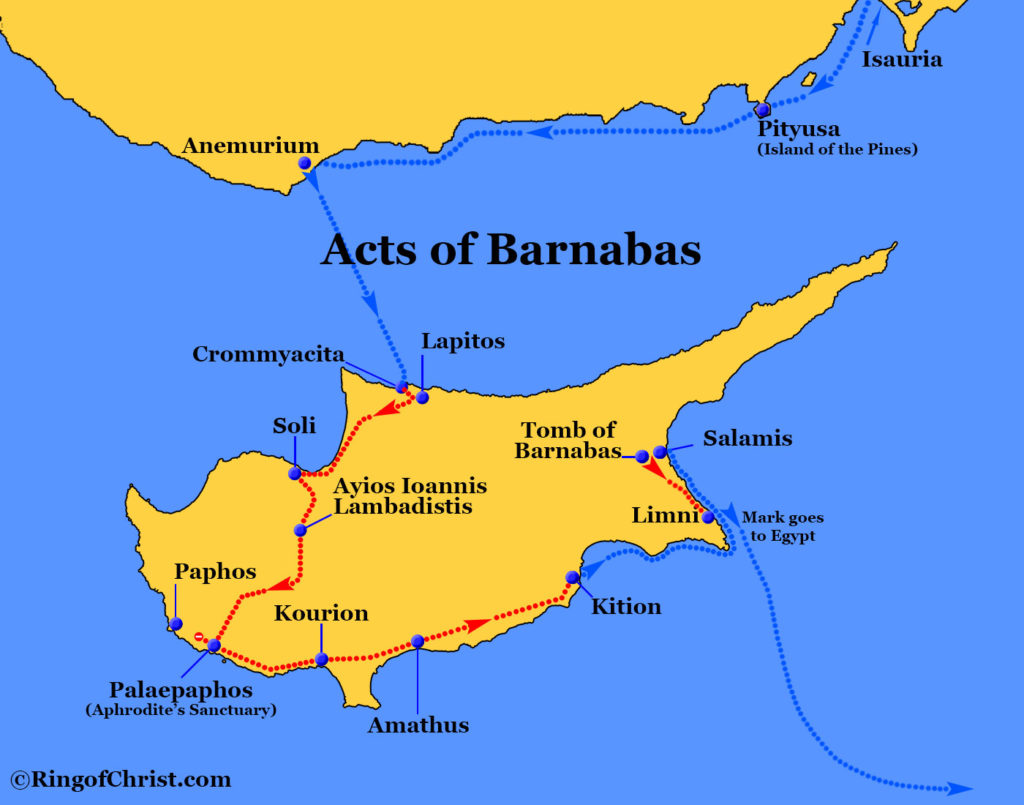
The route taken in Acts of Barnabas by Barnabas and Mark can still be easily traveled today, for many of the place names are the very same, others very similar. As Mr. Walker noted the author knew the geography of the whole region and described well the activities at various commercial and cult centers of the Roman period.
Barnabas and Mark return to Cyprus without Paul
Following the route of Barnabas and Mark from Laodiceia to Crommyacita and then around Cyprus on their second mission by using this document gives great credibility to its authenticity. The fact that it could well be a valid history of their efforts in Cyprus and the part they played also validates the account, especially by the presence of the names of ordained bishops in official church records.
Acts of Barnabas begins in Antioch; Paul was angry with John Mark and wanted nothing to do with him. Acts of Barnabas explains and provides details about why Paul would not travel with the pair. John Mark had deserted them in Pamphylia and had stayed there too long, for two months. John Mark had also left important parchments in the city instead of taking them back to Antioch.
Barnabas tried to reason with Paul, and John Mark apologized, but no pleading would change Paul’s mind. Finally, the apostles had such a sharp disagreement that they parted company (Acts 15:39).

When taking a boat from the Levant to Northern Cyprus in winter, the strong northwest winds would have been against them. The craft would have had to skirt the southern coast of Turkey trying to avoid the winds, stopping at various ports along the way which are actually listed in the right sequence in the document. Strong southern winds prevail across the Mediterranean Sea the rest of the year, so only at that time, in winter, would a sailing route skirting Turkey’s southern coast from east to west have been followed.
Most of the ports are recognizable today: Corasium has the same name. Isauria was part of Cilicia, the Island of Pityusa (Island of Pines, there are two islands heavily forested), and Aconesiæ which is not known, then on to Anemurium, Anamur today. Then they left Turkey and sailed by night to Crommyacita (today Kormakiti, a Maronite Village) on the north coast of Cyprus.
Once in Cyprus, they traveled east to Lapithos where an idol festival was going on; it was a major cult and commercial center and one of the four principal Roman districts of the island. At Lapithos they picked up the mountain road and headed south through the mountainous central region.
They stopped at Lambadistis where they found Heracleius who was from Tamasos. Barnabas and Paul had met him in Kition (Larnaca) on their first trip. Barnabas ordained him Bishop of Cyrpus.
NOTE: Did Barnabas arrange to meet him in Salamis, because Heracleius was waiting there when Barnabas and Mark arrived? He apparently went across the Mesaoria Plain, a flatter more direct route.
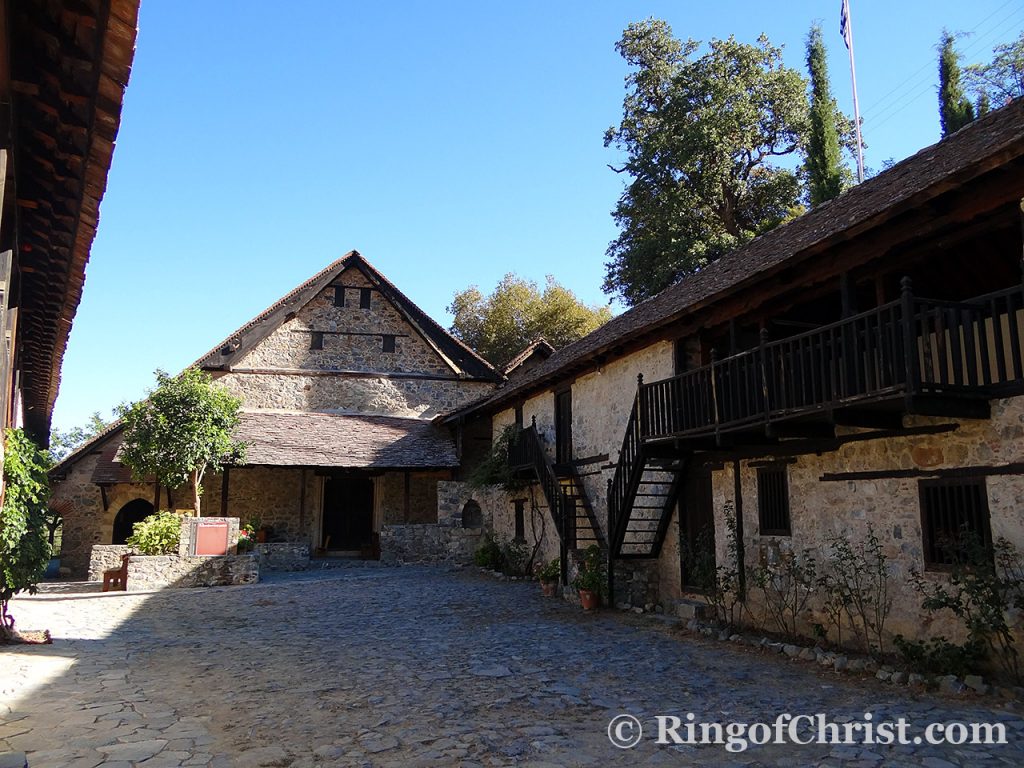

While today there is beautiful church complex in his name at Lambadistis, Heracleius himself is buried at the St. Herakleidios Monastery in the village of Politiko.
They passed the mountain called Chionodes (the old name of Mt. Olympus of Cyprus) taking the road to the southern coast.

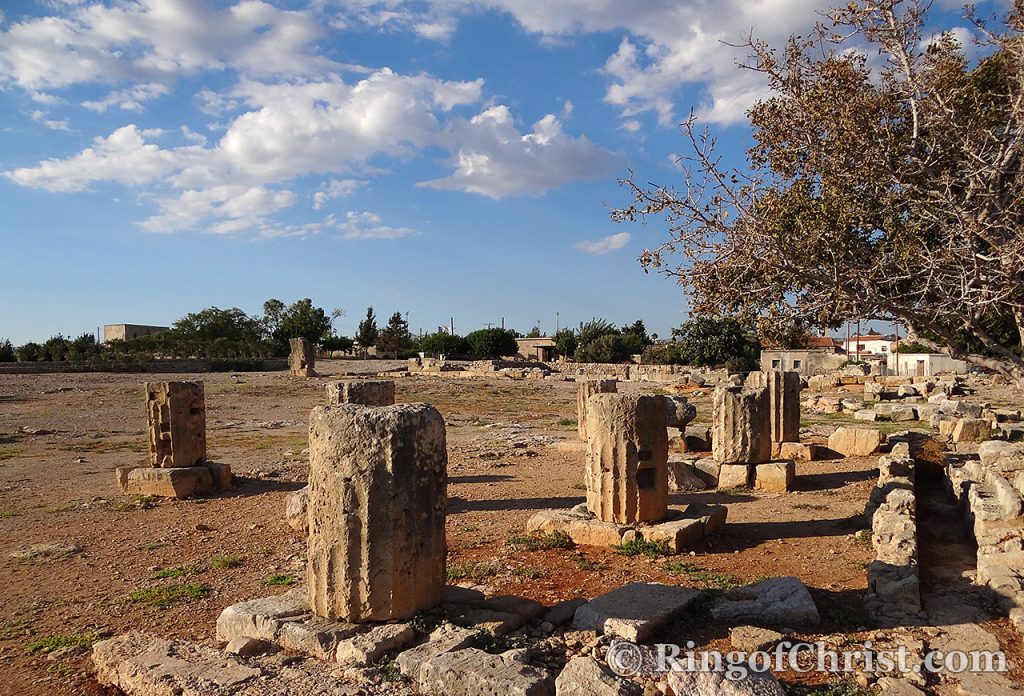
The trip was uneventful after leaving Lambadistis, until they reached Paleopaphos (Aphrodite cult center) on the way into Nea Paphos, the seat of Roman government on the island. There they were most probably wanted to meet the new Proconsul, who had replaced Sergius Paulus.
This time they were stopped by Elymas (Barjesus) and a gang of jews, and were not permitted to enter the city. Elymas would not tolerate Barnabas preaching the miracle in the Paphos synagogue nor relate how he was struck blind by Paul. The powerful Elymas was determined to stop Barnabas at any costs.
So Barnabas didn’t go into Paphos; he turned around and headed east to Kourion. From that point on, the missionaries were stopped from entering every city along the coastal road built by Augustus. The Jews must have traveled on horseback or in carts since they were always ahead of Barnabas and his group who went on foot.

It is noteworthy that at Kourion Mark tells of ‘a certain abominable race’ that made Barnabas irate because he witnessed naked women and men running on the road near the stadium. (the road to the right is over the Roman road)

Women athletes competed in ‘bikini-style outfits’…Was this considered ‘naked’ by Barnabas ? And, another consideration: If this work was a 5th century document, how would the author know to place the ‘abominable race’ at this location when the area was most likely in ruins in the 5th century after major earthquakes and shifting sand?

The locations exist today exactly as described: the stadium, the entry to Kourion, the Temple of Apollo are all next to the Roman road they would have traveled, yet during the 5th century they would have been in ruins, because of the massive earthquake that devastated the island in 365 A.D.
The Acts of Barnabas – From Kourion to Salamis
They continued east on their way to Salamis being stopped from entering Kourion and Amathus. Even Lazarus didn’t come to meet them in Kition, so they ‘shook the dust off their feet,’ caught a boat, and sailed around Cape Greco to Salamis.
There were synagogues in all of the major cities, Paphos, Curium, Amathus, and Larnaca, some cities having more than one, as did Salamis. Barnabas’ mission was only to the Jews, so Elymas was determined to keep him out of the cities and thus out of the synagogues by calling on the Jews in those areas to keep the missionaries from entering the gates.
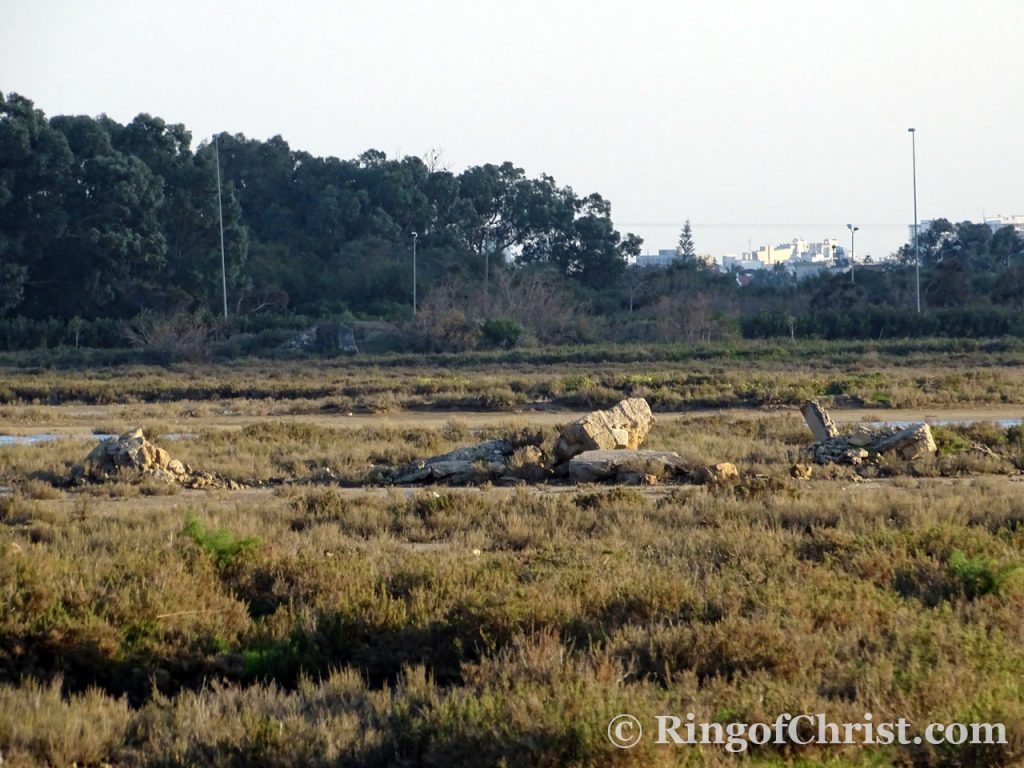
When they arrived in Salamis, Mark tells us they arrived at a place of idols where high festivals and libations took place. They apparently sailed into the mouth of the Pedieos River, which would have been silted up by the 5th century. When critics say that Acts was written, the islands of the idols would have been covered over, for Salamis had a new seaside port in the 5th century. Up unto what century would they have still been in existence and referred to? (Perhaps one day archaeologists will excavate this area.)
Today nothing remains except a few riverlets which wind through the silt and one small tree covered in small plastic bags of offerings and prayer requests. It seems that tradition still holds that this is a place of offerings.
Votive Tree at Salamis Estuary
Offering tree at the mouth of the silted up Pedieos River
This was the only time Barnabas and Mark outran Barjesus, who would have continued by road. The Christians arrived two days before he did, giving them time to preach in the synagogues without interruption. Heracleius was waiting for Barnabas and John Mark in Salamis; he must have taken the road from the mountains, across the plains, directly to Salamis. According to Acts of Barnabas, Barnabas taught him how to set up and manage Christian communities. It appears that the meeting in Salamis had been arranged in Lambadistis.
Catacombs at St Barnabas MonasteryCatacomb near the Tomb of St. Barnabas
And then Barjesus arrived. He was furious that Barnabas had outsmarted him, so he called on his fellow Jews to apprehend Barnabas and take him to Hypatius, the governor of Salamis, but when Barjesus found out that a pious Jesubite and relative of Nero was coming to town, he changed his mind because he was afraid the Barnabas would be released.
Instead, Barjesus (Elymas) had Barnabas taken to the outskirts of Salamis near the hippodrome and burned, planning to throw his remains into the sea the next day.
Map of ancient Salamis, showing the major structures Possible Site of the Hippodrome in Salamis
Mark says that late that night Timon, Rhodon, and himself secretly took the remains out of the city to a cave where they buried Barnabas. The body of Barnabas while burnt could not have turned to pure ash.
It would have taken about 600 pounds of wood and at least 6 hours to reduce the body to pure ash. It is unlikely that there was enough wood or time to complete the act, so Barnabas’ bones were most probably removed.
When Mark says that it took three of them to remove Barnabas to the burial site, that makes perfect sense. The remains of the body would have been rolled up tightly, and carried with one person at each end and one in the middle, needing three.
Mark goes into great detail relating how they were pursued, how they went out of town and found caves, then hid out for three days.
There is a massive ancient necropolis on the Mesaoria Plains barely a mile out of Salamis. It consists of huge tombs and an intricate catacombs network, a perfect place to hid out and to bury a body. This is the place where St. Barnabas was found, in a cave with the Gospel of St. Matthew. John Mark tells us the Matthew himself give the copy to Barnabas who used it to preach from and to heal with.
Rhodon, Timon, and John Mark left from a town called Limni, and took a boat to Egypt, where Mark founded the Coptic Branch of the Apostolic Church, and where the Coptic Church continues the tradition of Mark. Perhaps just coincidence, but the town of Paralimni today is just 12 miles from the tomb of Barnabas and is located on the coast south of Salamis.
So, is the document Acts of Barnabas a fake, written for the self serving purpose of the local church? There are enough elements of the story related by Mark to make someone wonder if it might just actually be true because it would have been a difference of four hundred years between related events and when critics say it was written. How would an author have known most of this information in the 5th Century when so much of it would have been covered by the sands of time?
As Alexander Walker says: “This book has more an air of truth about it than any of the others. There is not much extravagance in the details, and the geography is correct, showing that the writer knew Cyprus well.”
